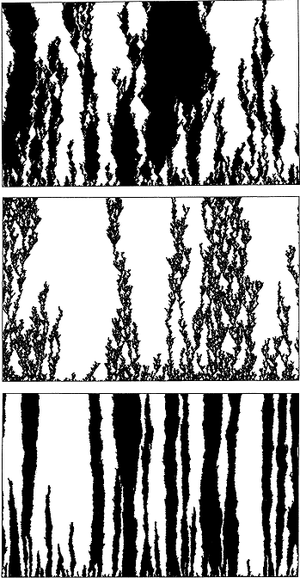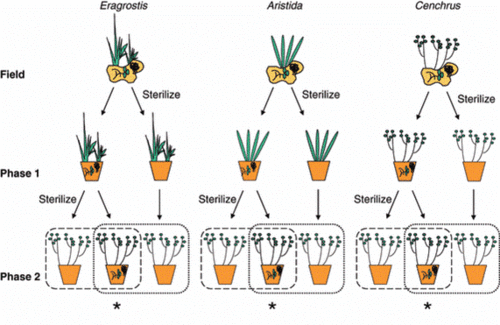Plant-soil feedback
Introduction
Definition
Changes to soil properties that are caused by plants, which in turn influence the performance of plants are termed as ‘plant–soil feedbacks’ (Putten et al., 2013). Through changes in the demography of the plant population and/or the physiological activity of the individual plants, the plant’s effect on the soil condition increases (positive feedback) or decreases (negative feedback) (Ehrenfeld et al., 2005). Microbial activity and community composition is considered as one of the major drive factor of plant-soil feedback effects (Bever et al., 2013; Klironomos, 2002)
Basic approaches
The basic idea of plant–soil feedback experiments is that plants first influence the composition of the soil community, which is called soil conditioning. Then, the effects of conditioning are evaluated by assessing soil effects on subsequent plant growth.
The earlier experiments testing plant–soil feedback effects were started from natural field-sampled soil. The strength of this method is that plants have influenced the soil for a long period of time under natural conditions. However, the weakness of this approach is that soils may differ in the composition of the soil community and abiotic properties.
A following developed approach was that plant species were grown in living soils to develop a soil community, which is the conditioning phase, followed by a test phase in which the growth response on changed biotic conditions was tested (Figure 1). The strength of this two-phase plant–soil feedback approach is that the effects are less dependent on possible side effects of local differences in abiotic soil conditions and that the plant species influencing the soil is controlled. But a potential weakness is that a different soil community may develop in pots under greenhouse conditions than in the field. And the growth responses in the feedback phase can be due to nutrient depletion in the first phase (Pernilla Brinkman et al., 2010).
History and importance
More than 2000 years ago in both Europe and Asia, it was known that fruit trees were subject to replanting failures when young trees were planted where conspecifics or congeners had grown. For more than 1000 years, humans have been aware of, and managed, plant–soil feedbacks in agriculture and horticulture. In agricultural settings, plant–soil feedbacks most often involves soil nutrient depletion or the build-up of species-specific, soil-borne pathogens. Rotational cropping systems were developed to reduce failures of crop establishment and to increase productivity. Ecologists have benefited greatly from insights into agricultural practices and the early knowledge about plant-pest and pathogen inter-actions (Putten et al., 2013).
Interest in plant–soil feed-backs has increased in the past 10 years. And many exciting results are released. Plant–soil feedbacks is becoming an important concept for explaining vegetation dynamics, the invasiveness of introduced exotic species in new habitats and how terrestrial ecosystems respond to global land use and climate change.
Factors that influence the results of plant-soil feedback
Physical factors
Water: The potential for feedback involving water comes from the capacity of plants to alter the distribution and amount of water in the soil, potentially affecting their growth and reproduction. These pathways can cause successional change driven by plant response to changing soil moisture conditions or by the maintenance of stable plant assemblages stemming from increased soil moisture.
Soil aggregation results from a variety of root-mediated processes, including wet-dry cycles enhanced by plant water uptake, the physical pressures exerted by roots growing through cracks, and the direct effect of roots and their associated mycorrhizae in binding soil minerals together. Roots affect aggregation through plant carbon (C)-based microbial growth, the production of plant and microbial mucilages, the presence of phenolic compounds in root exudates, and the overall input of SOM. Feedback between plants and the physical properties of soils arise from the promotion of aggregates by roots and root-associated microorganisms.
Soil temperature affects root growth, water availability, and microbial activity, thus affecting both nutrient cycling and soil respiration.
Chemical factors
pH: Plants are an important factor in the acidification of soils through several pathways including the generation of carbonic acid from root and root-supported microbial respiration, the leaching of organic acids, and imbalances in the uptake of positive and negative ions. It is generally presumed that the pathways of soil acidification involve feedbacks: plant-induced acidification promotes conditions under which only acidophiles can live.
Oxygen: Wetland plants are well known for their ability to release oxygen from their roots, thereby modifying the sequence of redox reactions that characterize anoxic soils. Wetland species vary greatly in the extent of root oxygen loss and their tolerance for reduced chemical conditions. These plant generated effects on soil chemistry are presumed to be part of a feedback cycle.
Carbon and nitrogen cycle: The interplay among plant species, plant communities, N and C cycling has generated more discussion of feedback in the soil-plant system than any other topic. Frequently proposed feedback mechanisms include the linkage of decomposition and mineralization rates, the linkage between chemical forms of N and their up-take by plants, competition between microbes and plants for N, and plant-mediated effects on ecosystem inputs and outputs. There are also multiple pathways of feedback between plants and soil C, operating over a wide range of temporal and spatial scales and often operating through complex (multifactor) pathways.
Biotic factors
Plant-soil feedback could cause changes between plants and soil community composition, and those changes in communities result in changes in function in either party to the interaction.
Mutualism: Mycorrhizal mutualisms are known for their diverse beneficial effects on plants, especially for nutrient uptake, plant defense and plant resistance to abiotic stresses. Usually the plant initiates a positive feedback that results in better nutrition, thus increasing fitness for both the plant and the microorganism.
Antagonism and parasitism: Many studies have shown that the development of below-ground pest populations relative to the growth of particular species can drive ecosystem succession, affect tree seedling recruitment near parental trees, promote the invasion of exotic plant species and alter competitive relationships and community structures (Ehrenfeld et al., 2005).
Current research

Plant–soil feedbacks is becoming an important concept for explaining vegetation dynamics, the invasiveness of introduced exotic species in new habitats and how terrestrial ecosystems respond to global land use and climate change.
Primary and secondary succession
Early successional stages are often associated with positive plant–soil feedbacks, for example, due to symbiotic nitrogen fixation and plant associations with mycorrhizal fungi. Then the initial benefit of symbioses may become a disadvantage when early successional plant species develop negative soil feedback such as the pathogen accumulation. This reduces their competitive ability against later successional plant species which are tolerant of the pathogens accumulated by earlier successional species. Moreover, plant community composition in early stages of secondary succession can also change rapidly due to negative plant–soil feedbacks. For example, in a series of old fields that differed in time since abandonment, early successional (weedy) plant species demonstrated negative feedback effects, whereas later successional species had positive plant–soil feedbacks effects (Kardol et al., 2006; Putten et al., 2013).
Biological invasion
The success of many invasive species can be explained by plant-soil feedback method. One of the main reasons why exotic species can become so invasive in their new range is that they become released from specialist natural enemies that control abundance in the native range. In a study in a Canadian old field, introduced exotic plant species had neutral to positive plant–soil feedbacks comparable to dominant native plant species which had negative feedbacks (Klironomos, 2002). This finding was taken to suggest that exotic plant species could become invasive by not being exposed to negative plant–soil feedbacks (Putten et al., 2013).
Plant abundance and rarity
Plant-soil feedback can be used to explain the relative abundance and rarity of plant species. Recent work has shown that reduced success of conspecific seedlings near adults (conspecific negative density dependence) in the tropics can be attributed to local scale plant–soil feedbacks (Mangan et al., 2010). Failed establishment of black cherry (Prunus serotina) seedlings under conspecific adults was due to pathogenic soil microbes (Pythiumsp.). Subsequent work has suggested that the decline in performance and abundance of seedlings near conspecific adult trees is common in both tropical and temperate forests (Putten et al., 2013).
Climate change
Both temperature increases and altered precipitation patterns are likely to influence plant–soil feedbacks, with potentially far-reaching consequences for ecosystem functioning. Climate change is likely to impact the soil organisms directly because warming of the soil can stimulate microbial activity, the breakdown of organic matter and hence the loss of carbon from soil. The numerous routes by which climate change can impact plant–soil interactions and ecosystem functioning can operate at a variety of spatial and temporal scales. At the individual plant level, and over intra- and inter-annual timescales, changes in temperature, water availability and rising atmo-spheric carbon dioxide (CO2) concentration, all impact plant photosynthesis and the transfer of photosynthetic carbon to soil, with cascading effects on soil organisms and ecosystem functioning.
References
Edited by <Meng LI>, a student of Angela Kent at the University of Illinois at Urbana-Champaign.

